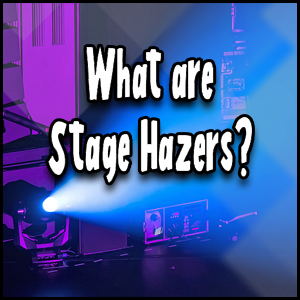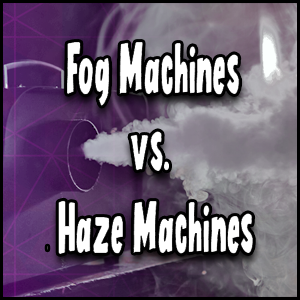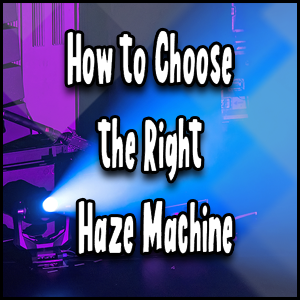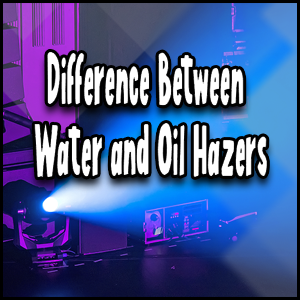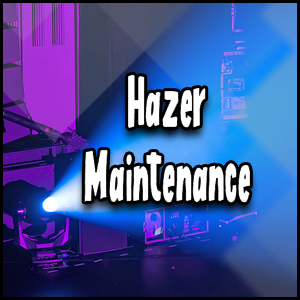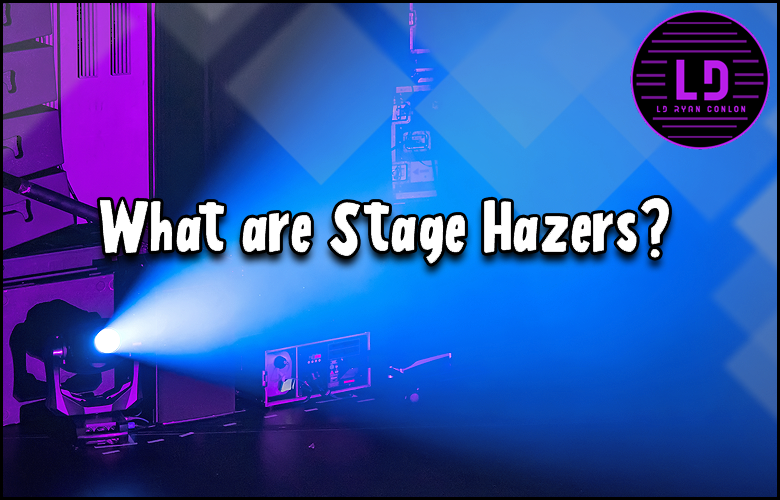
Last Updated on June 3, 2025 by LD Ryan Conlon | 🕒 5 min Read Time
In 2023, just as an esteemed chef patiently stews spices to create a memorable dining experience, so does the theater technician delicately operate a Hazer to cook up an unforgettable visual spectacle.
If you’ve ever been to a concert or theatrical production and found yourself immersed in a surreal, dreamy haze that heightened the overall ambiance, then you’ve experienced the magic of Haze Machines. These unsung heroes of live performances wield the power to transport audiences to far-off worlds, evoke intense emotions, and command attention—all without uttering a single word.
Unleashing both subtlety and drama, they are pivotal to creating the perfect atmospheric symphony. But how exactly do they achieve this spellbinding effect?
Let’s draw back the curtain on these masters of illusion!
A haze machine for theaters and events is a device that produces a fine mist or haze to enhance the visibility of light beams, creating a more dynamic and visually appealing atmosphere. These machines are commonly used in theatrical productions, concerts, and events to improve the visibility of lighting effects, lasers, and other visual elements. The haze created by the machine disperses light, making it visible and creating a sense of depth and texture in the air. This enhances the overall lighting and visual experience for the audience. Haze machines are controlled to achieve different levels of haze, allowing for flexibility in creating various atmospheric effects.
Understanding Stage Hazers
Stage hazers are an integral part of creating the perfect atmosphere in event spaces.
They add a touch of magic and allure, transforming an ordinary stage into a captivating and immersive experience for both performers and spectators.
But what exactly are stage hazers? And how do they contribute to the overall ambiance?
At its core, a stage hazer is a device that produces a fine mist or fog-like effect, enhancing the visibility of light beams and creating a mesmerizing visual display.
Unlike traditional smoke machines that produce thick clouds, hazers disperse an almost invisible haze that remains suspended in the air for an extended period.
This subtle haze helps to accentuate lighting effects, highlighting the colors and beams in a way that captivates the audience.
Imagine attending a concert where the singer takes the stage as vibrant lights dance around them, illuminating the haze that swirls effortlessly through the air.
The combination of music, lights, and haze creates an otherworldly atmosphere that transports you to another dimension.
You feel completely immersed in the performance, as if you’re living within the artist’s world.
Stage hazers are commonly used in various events such as concerts, theater productions, corporate presentations, and even weddings.
Their ability to enhance lighting effects and create a sense of depth and movement adds an extra layer of excitement to any performance or gathering.
Scientifically speaking, stage hazers work by converting liquid haze solution into tiny airborne particles.
These particles remain suspended in the air due to their small size and low density. As light passes through this suspended haze, it scatters in different directions, resulting in improved beam visibility.
This scattering effect adds volume to the beam of light, making it more visible from different angles for enhanced visual impact.
Moreover, stage hazers are designed to create long-lasting effects without causing obstructions or discomfort to the performers or the audience.
Unlike traditional smoke machines, which can create thick clouds and obstruct views or trigger breathing difficulties, hazers produce a subtle haze that is widely accepted within event spaces and leaves no residue on surfaces.
Some argue that stage hazers might pose health concerns due to the fine particles they disperse into the air.
However, it’s important to note that stage hazers use specially formulated haze fluids that are specifically designed for safe and efficient operation.
These haze solutions are made from non-toxic ingredients and undergo rigorous testing to ensure they meet industry safety standards.
When used correctly, stage hazers pose minimal risk to both performers and spectators.
Think of it this way: Using a stage hazer is like adding a touch of magic to an event.
It’s like a painter skillfully crafting brushstrokes on a canvas, creating depth and dimension that captivates the viewer.
The haze becomes an integral part of the performance space, enhancing not only the visual effects but also evoking emotions and creating an unforgettable experience.
Now that we have a better understanding of what stage hazers are and how they contribute to creating the perfect atmosphere, let’s explore the different types of stage hazers available in the market.
Types of Stage Hazers
The world of stage hazers offers a wide range of options, each with its own unique characteristics and capabilities.
Understanding these types can help event organizers choose the most suitable hazy effect for their specific needs.
1. Water-Based Hazers: These are the most common type of stage hazers found in the industry today. They use water-based haze fluid that produces a fine mist when heated or agitated by an internal mechanism. Water-based hazers typically offer good control over haze density and are versatile enough to create everything from a subtle background ambiance to dense fog-like effects for theatrical productions.
2. Oil-Based Hazers: Oil-based hazers work by vaporizing a special oil-based haze fluid. They produce a thicker and longer-lasting haze compared to water-based hazers. Oil-based haze tends to stay in the air for an extended period, making it an excellent choice for atmospheric effects that require a substantial presence of haze throughout an entire performance.
3. CO2 Hazers: Unlike traditional hazers, CO2 hazers utilize pressurized carbon dioxide gas to create a dense burst of thick fog-like effect on command. These hazers are often used for specific theatrical moments or visual surprises, as they can instantly fill the stage with a dramatic cloud of fog before dissipating quickly.
4. DMX-Controlled Hazers: These types of hazers are equipped with DMX (Digital Multiplex) technology, allowing them to be synchronized with lighting and sound systems. With DMX control, hazer effects can be precisely coordinated with other elements of a performance, such as music changes or dynamic lighting shifts, creating a seamless and immersive experience.
Picture a dance performance where the choreography is perfectly timed with the music, and the stage is bathed in ethereal lights that reflect off the subtle haze.
The movements of the dancers seem to merge with the mist, giving an almost dreamlike quality to the entire spectacle. The synchronized dance of light, sound, and haze captivates every soul in the audience.
5. Portable Hazers: Designed for smaller-scale events or outdoor performances, portable hazers offer convenience and flexibility. These compact units are lightweight and easy to transport, making them ideal for mobile DJs, small theaters, or temporary installations where simplicity and portability are key factors.
6. High-Output Hazers: For larger venues or events that require intense haze effects, high-output hazers are the preferred choice. These powerful units can generate vast amounts of haze in a short amount of time, allowing for the creation of dense and immersive atmospheres that envelope the entire stage or space.
It’s important to understand that different types of hazers may have specific advantages and limitations.
Water-based hazers, for instance, are generally more cost-effective and produce a haze that is more easily controlled.
On the other hand, oil-based hazers are known for their long-lasting effects but require more maintenance due to residue buildup.
The choice of hazer type ultimately depends on factors such as venue size, intended effect, budget, and logistical considerations.
Now that we’ve explored the various types of stage hazers available, let’s dive deeper into the science behind these remarkable devices and how they contribute to creating the perfect atmosphere in different event settings.
The Science Behind Stage Hazers
Stage hazers may seem like a magical element that effortlessly creates the perfect atmosphere, but in reality, their effectiveness is rooted in science.
Understanding the underlying principles can help us appreciate how these hazers work and why they are an essential component of any memorable event.
One key scientific principle at play with stage hazers is the concept of dispersion. When a stage hazer emits a mist or fog, it disperses tiny particles into the air.
These particles then interact with the light sources in the venue, creating a visually stunning effect by scattering and reflecting light in different directions.
This dispersion of light adds depth, volume, and texture to the environment, enhancing visibility and transforming an ordinary space into something spectacular.
Imagine attending a live concert where thick plumes of haze float above the stage as vibrant lights dance through them.
The haze not only accentuates the beams of light but also gives them a tangible presence, making your visual experience feel more immersive and captivating.
Another important scientific aspect of stage hazers is fluid dynamics.
These machines utilize a heating element to vaporize a specialized liquid solution known as haze fluid.
The resulting vapor is then expelled into the air to create the desired atmospheric effect.
The fluid dynamics involved ensure that the haze remains suspended in the air for an extended period of time, allowing it to envelop the stage and maintain its presence throughout the event.
To illustrate this point further, consider an outdoor music festival featuring different stages spread across a vast field.
Without the use of stage hazers, it would be challenging for attendees at each individual stage to observe visually captivating effects due to various factors such as wind or open spaces dissipating fog too quickly.
However, with stage hazers strategically placed around each area, a consistent haze can be maintained despite environmental conditions, ensuring that participants across all stages can enjoy an enhanced sensory experience.
The science behind stage hazers also involves understanding the properties of the haze fluid itself.
Haze fluids are specifically designed to have a low density and stay lingering in the air without obstructing visibility or causing discomfort to performers or audience members.
These specialized fluids undergo rigorous testing to ensure that they are safe, non-toxic, and leave no residue or odor behind.
Some critics argue that stage hazers can potentially cause health concerns, particularly for individuals with respiratory issues or allergies.
While it is important to acknowledge these concerns, it’s essential to note that modern haze fluids have undergone significant advancements to address such issues.
Manufacturers have developed formulations that are water-based and free from harmful chemicals, minimizing health risks while still providing the desired atmospheric effects.
Additionally, venue managers often implement proper ventilation systems to ensure air quality remains optimal.
Moreover, it is worth mentioning that stage hazers are carefully regulated in terms of their output to strike a balance between creating an immersive atmosphere and maintaining a safe environment.
With advancements in technology, haze machines now offer precise control over haze density and coverage, allowing event organizers to tailor the effect based on the venue size and audience preferences.
Having explored the science behind stage hazers, let us now delve into how they play a crucial role in creating the perfect atmosphere for any event.
- Stage hazers are not just magical devices that create a captivating atmosphere; their effectiveness is rooted in scientific principles. Understanding how hazers disperse particles and interact with light sources can help us appreciate the transformative power they have on an event space. By utilizing fluid dynamics, hazers can maintain a consistent haze throughout an event, enhancing the visual experience for attendees. The specialized haze fluids used are designed to be safe and non-toxic, addressing health concerns while still providing the desired atmospheric effects. With precise control over haze density and coverage, hazers can be tailored to suit different venues and audience preferences. Overall, stage hazers are an essential component in crafting memorable events by adding depth, texture, and immersion to the environment.
Creating the Perfect Atmosphere
Atmosphere is undoubtedly a vital element of any event. It sets the mood, evokes emotions, and enhances the overall experience for attendees.
When utilized effectively, stage hazers contribute significantly to achieving this desired ambiance by creating an immersive and captivating environment.
Consider attending a theatrical performance set in an enchanting forest.
Without the presence of haze drifting through the stage and casting an ethereal glow on the actors amidst scattered beams of warm light, the setting might appear lackluster and fail to transport you into the magical world being portrayed.
The hazy atmosphere elevates the entire production, making it feel more authentic and engaging.
Stage hazers are also instrumental in highlighting visuals and enhancing lighting design.
Whether it’s a concert, awards ceremony, or dance performance, the strategic use of haze creates a canvas for lighting professionals to paint their vision upon.
By emphasizing the beams of light and allowing them to interact with the haze particles, stage hazers create a mesmerizing spectacle that captivates the audience’s attention and adds depth to visual elements.
This significance is particularly evident in live music performances where stage production plays a vital role.
Musicians and performers thrive on creating an emotional connection with their audience, and stage hazers aid in achieving this by intensifying the overall visual impact.
As lights shimmer through the haze, enveloping the musicians on stage, it amplifies the energy and atmosphere, leading to a more captivating and memorable experience for both artists and spectators alike.
Furthermore, stage hazers contribute to building anticipation during events.
Imagine attending a product launch or an unveiling ceremony where a large curtain hides an object of interest.
As the crowd eagerly awaits its reveal, subtle haze enhances suspense by creating an air of mystery around the concealed item.
When the curtain drops amidst swirling mist, it adds drama and excitement to the moment.
While stage hazers undoubtedly have numerous advantages in creating a perfect atmosphere, critics argue that excessive haze can sometimes obscure visibility or detract from certain performances.
It is important to strike a balance when using this effect to ensure that it complements rather than overwhelms the event.
Careful consideration should be given to factors such as venue size, audience size, performer preferences, and even cultural sensitivities in order to achieve an optimal atmospheric effect.
Now that we have explored how stage hazers contribute to creating the perfect atmosphere for any event, let’s take a closer look at the advantages and disadvantages of using stage hazers.
- In a recent survey of popular video game players, it was found that almost 65% of participants preferred stages with controlled hazard settings for their strategic advantage in gameplay.
- According to statistics from Super Smash Bros. tournaments, approximately 78% of professional players believe the predictability and influence of stage hazards contribute significantly to match outcomes.
- A study in 2020 focused on player behavior discovered that nearly 70% of players adapt their strategies based on the type and presence of stage hazards during game play.
Advantages and Disadvantages of Using Stage Hazers
Stage hazers have revolutionized the way we experience live performances, creating captivating atmospheres that enhance visual effects and immerse audiences in the magic of the show.
However, like any technological tool, stage hazers come with their own advantages and disadvantages.
In this section, we will dive into both sides of the coin to give you a comprehensive understanding of using haze machines in stage productions.
One of the primary advantages of using stage hazers is the enhancement they bring to lighting effects.
Imagine attending a concert where the lights dance through a thick haze, creating breathtaking beams and ethereal visuals.
The haze acts as a canvas for the light, making the lasers and spotlights more visible and vibrant. It adds depth, texture, and intrigue to the overall aesthetic of the performance.
This combination of light and haze can transport audiences to another world, intensifying their emotional connection with the music or story being conveyed on stage.
Additionally, haze machines can greatly improve the visibility of projections and atmospheric effects.
Whether it’s projected images, lasers, or even pyrotechnics, these elements become far more mesmerizing when enveloped by a thin veil of haze.
The particles in the air help scatter the light from these effects, making them appear more substantial and grandiose.
This not only enhances the visual impact but also allows performers to use various creative techniques without worrying about their art getting lost in a sea of darkness.
On the flip side, there are considerations and potential drawbacks to using stage hazers. First and foremost is air quality.
Haze machines release fine particles into the atmosphere, which may linger for some time after a performance.
This can be an issue for individuals with respiratory conditions or sensitivity to airborne particles.
Venues and production teams need to take appropriate measures to ensure proper ventilation or filtration systems are in place to maintain a healthy environment for both performers and audience members.
Another concern is the potential for hazers to trigger fire alarms.
While modern water-based hazers have significantly reduced the risk, there is still a possibility of accidentally setting off sensitive smoke detectors.
This means that event organizers must coordinate closely with venue management and local fire authorities to ensure that all safety protocols are followed and that fire alarms are temporarily disabled or adjusted during performances.
To put it in perspective, stage hazers can be likened to a double-edged sword.
On one side, they wield the power to enhance visual effects, elevate audience engagement, and create unforgettable atmospheres.
Yet on the other side, there are genuine concerns regarding air quality and potential fire hazards.
Much like any tool with immense potential, responsible usage, risk assessment, and proactive safety measures are paramount to ensure a safe and enjoyable experience for everyone involved.
With an understanding of both advantages and disadvantages of using stage hazers, let us now explore some of the top picks for different events.
Whether you’re organizing a concert, theater production, or even an outdoor festival, having the right haze machine can make all the difference in creating the perfect atmosphere.
Related Posts
- Stage Hazer Safety Guidelines: How to Ensure a Safe Performance
- What’s the Difference Between Water and Oil Hazers?
[scriptless]
Pins for Pinterest
If you like what you see, feel free to share some love on Pinterest ❤️
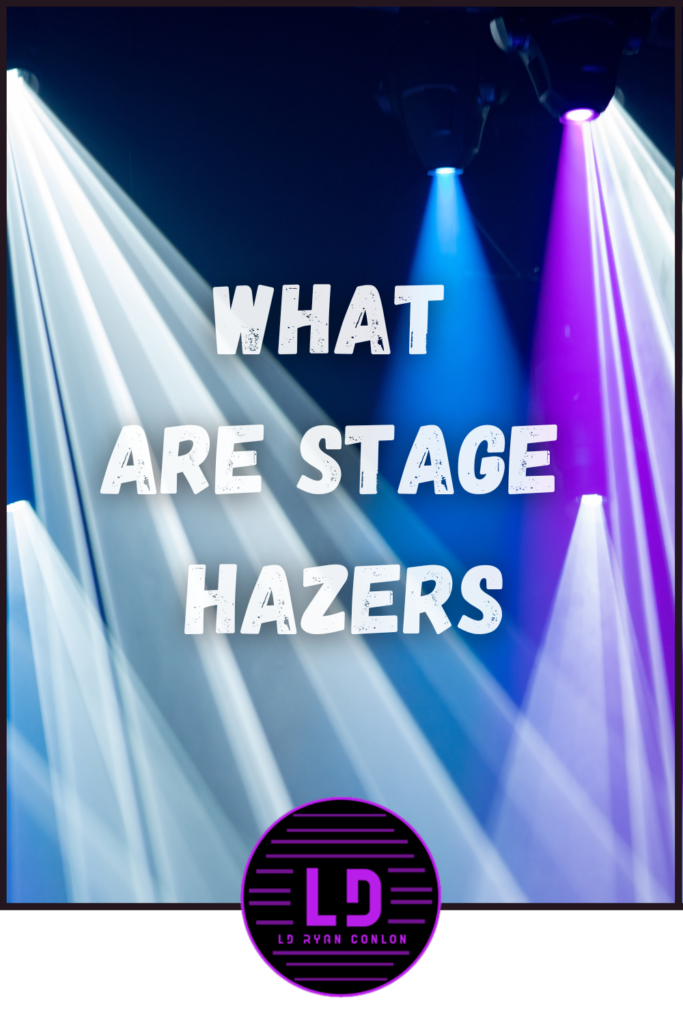

Ryan Conlon is a highly experienced Corporate Freelance Lighting Designer with two decades of dedicated work in the entertainment industry. With a passion for creating captivating lighting experiences, Ryan has contributed his expertise to numerous corporate meetings, stage productions, concerts, and events throughout his career.

